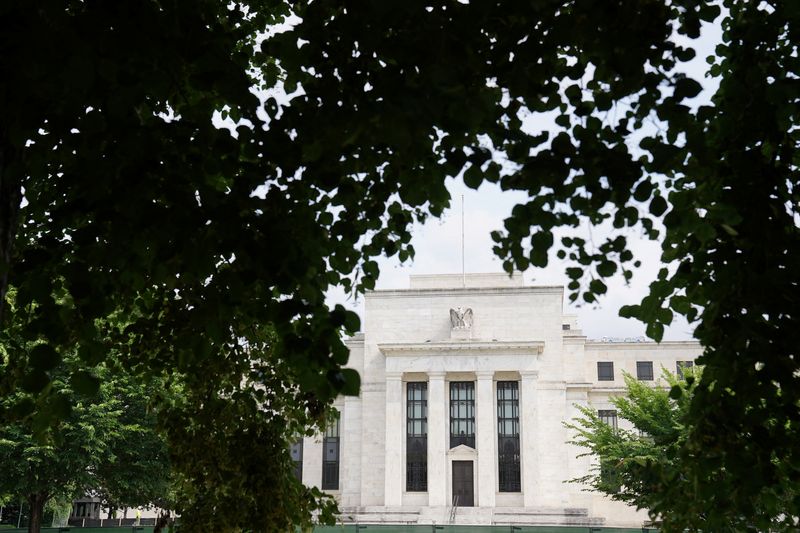By Ann Saphir
(Reuters) -U.S. central bankers may be having second thoughts about their decision earlier this week to hold borrowing costs steady, after a government report on Friday showed the job market slowed sharply last month.
Employers added just 114,000 jobs in July, the U.S. Labor Department reported, and the unemployment rate rose to 4.3%, from 4.1% in June, marking an unexpected deterioration in a labor market that had held up surprisingly well during the Federal Reserve's aggressive rate-hike campaign in 2022 and 2023.
On Wednesday, when U.S. central bankers opted to keep the central bank's policy rate in its current 5.25%-5.50% range, Fed Chair Jerome Powell said he believed the labor market was in a process of "ongoing, gradual normalization" that allows policymakers to wait a little longer to be sure inflation is beaten before cutting rates.
"If Powell knew then what he knows now, he probably would have cut rates," said Brian Jacobsen, chief economist at Annex Wealth Management. "By keeping rates on hold while inflation fell, they've applied too much pressure on the brakes."
The data prompted traders to pile into bets that the Fed will deliver a half-percentage-point rate cut at its Sept. 17-18 meeting, and drive borrowing costs down further from there, with the policy rate expected to end 2024 in the 4.00%-4.25% range.
Analysts at many Wall Street banks tore up their forecasts and wrote new ones. Goldman Sachs, for example, now sees a steady every-meeting series of Fed rate cuts and Citi called for half-percentage-point cuts in both September and December. JP Morgan said there was a strong case for a cut even before the Fed's next meeting.
"I would not like to see material further cooling in the labor market," Powell told reporters on Wednesday. "If we see something that looks like a more significant downturn, that would be something that we would ... have the intention of responding to."
Before the release of Friday's employment report, rate futures had been priced for quarter-percentage-point rate cuts starting in September.
"This week's Fed inaction was a mistake; the case for 50 basis points in September is strong," Ian Shepherdson, chief economist at Pantheon Macroeconomics, wrote. "July's poor employment report leaves the Fed looking woefully behind the curve."
Speaking after the jobs data was released, Chicago Fed President Austan Goolsbee said the central bank should not overreact to a single month of data, but also repeated his warning that leaving the policy rate where it is even as inflation falls means making an already restrictive policy even more so.
"Our absolute goal now is we want to settle at something like full employment, not blow through normal and deteriorate," he told Bloomberg TV.
SAHM RULE
Analysts noted that some of the underlying data was not as weak as the headline numbers suggested. Workforce growth was substantial, with the labor force participation rate ticking up to 62.7% from 62.6%, and participation among prime-age workers hitting 84%, its highest level in more than 20 years.
And while the Bureau of Labor Statistics said there was no impact on the data from Hurricane Beryl, many were skeptical, noting that the number of people who reported they were unable to work due to weather rose to a July record of 436,000.
That, along with the fact that fewer businesses than usual responded to the monthly jobs survey, raises the likelihood that some of the weakness will be revised away in future reports, analysts said.
The rise in the jobless rate last month triggered the so-called Sahm rule, a historically accurate early indicator of recession that says such a downturn is underway when the three-month moving average of the unemployment rate rises half a percentage point above its low from the previous 12 months.
Claudia Sahm, an economist who worked at the Fed, has cautioned against taking too much of a signal from her rule, given the labor market disruptions of the COVID-19 pandemic. Powell this week called it a "statistical regularity" that did not mean a recession "must happen."
Even so, the increase has ignited concern that the Fed may have waited too long to cut rates, and will need to play catch-up with large cuts in borrowing costs to cushion the economy.
In June, U.S. central bank policymakers in their quarterly projections anticipated only one cut this year, and saw the unemployment rate ending the year at 4%.
With the jobless rate now well above that, "the soft landing in the U.S. labor market is in danger," wrote Nick Bunker, director of North American economic research at Indeed Hiring Lab, referring to a scenario in which inflation is tamed without a painful recession or sharp rise in unemployment.

Powell on Wednesday said policymakers were not currently considering a half-percentage-point cut in September.
"What we think we're seeing is a normalizing labor market and we're watching carefully to see if it turns out to be more," he said, adding that the Fed was "well-positioned to respond" if it started seeing signs that there was something more going on.
